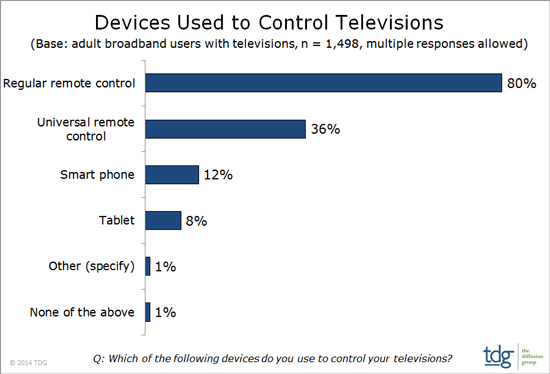16% of U.S. broadband-enabled pay-TV households use mobile device to control the TV
Thursday, May 15th, 2014
TDG: 16% of Broadband-Enabled Pay-TV Households Use Mobile Device to Control their Television
- New research finds that almost two-thirds of broadband households have at least one net-connected TV in their home
PLANO, TX — According to new data from The Diffusion Group (TDG), 16% of adult broadband users utilize a smart phone or tablet to control their television. More specifically, 12% of adult broadband consumers use a smart phone to control their home television, with 8% using a tablet for this task. Only 4% report using both devices for TV control purposes.

In combination, the total number of consumers using mobile or portable devices for TV control is less than half the number using so-called “universal” remote controls (36%) – remotes capable of controlling multiple platforms as opposed to a single device. According to TDG, these non-IP multi-device remote controls primarily come with high-end AV and home theater systems, or are distributed through operators for use with their premium service packages. Very few are after-market custom configurations.
“While mundane to many, this data is of great importance to TV OEMs, pay-TV service providers, and any company looking to “enhance” the in-home TV experience via the use of second screens,” notes Michael Greeson, President and director of research at TDG. “In fact, getting consumers to use these devices to control the basic functionality of their televisions is an influential first step towards more widespread use of social TV applications. Not all will fall in line, but original control use casts a much wider net.”
Despite the expanding role that mobile and portable IP-based devices are playing in controlling the television, fourth-fifths (80%) of these consumers still use the a basic RF OEM remote control, suggesting that, even in cases where a universal remote, smart phone, or tablet is used, so too is a traditional single-device remote control. In fact, 70% of those that use either a smart phone or tablet to control their TVs also use a traditional IR-based TV remote control, as do 41% of those that use a universal remote.
“This is most certainly a market in transition, and it is a win-win for most involved,” notes Greeson. “For TV OEMs, it offers the promise of one day eliminating the cost of remote controls altogether, or require a separate fee to get one. For operators, if they brand the control app, it puts their user interface and control guide on the second screen, where it can encourage more than just control. For social TV companies, the wider the net is cast, the more users will be open to their solution.”
TDG’S Q1 primary research study – Benchmarking the Connected Consumer, 2014 – randomly surveyed 1,500 adults that subscribe to a home broadband service. The project examines a broad array of behaviors across a multitude of net-connected devices, from net-connected TVs to tablets, and from PCs to smartphones. This is the fourth iteration of this annual study. For more information about this project, please contact TDG at 469-287-8050 or sales@tdgresearch.com.
Latest News
- Aferian to implement further cost reductions at Amino
- Paramount to exclusively represent SkyShowtime advertising sales
- Sky Sports Main Event latency reduced on Entertainment OS devices
- Netflix posts first quarter 2024 results and outlook
- Graham Media Group selects Bitmovin Playback
- Dialog, Axiata Group, Bharti Airtel agree on merger in Sri Lanka